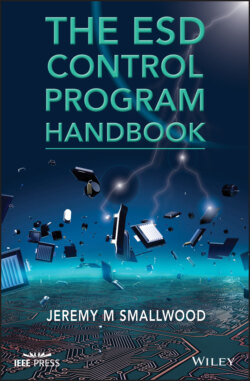Читать книгу The ESD Control Program Handbook - Jeremy M. Smallwood - Страница 47
2.2.1 The Polarity and Magnitude of Charging
ОглавлениеThe polarity of charge left on a material can be positive or negative and depends on a range of factors, especially on the other material with which it made contact. Materials may be arranged in a table according to the polarity of charge they take in contact with other materials, called the triboelectric series (see Table 2.1).
A material in the table (e.g. aluminum) can be expected to charge positively against another material below it in the table (e.g. polytetrafluoroethylene (PTFE)) and negatively against a material above it (e.g. wool). The amount of charge generated is a function of the separation of the materials on the table; aluminum and paper can be expected to charge relatively little against each other, but polyvinylchloride (PVC) and nylon can be expected to charge strongly against each other.
In practice, triboelectrification is a variable phenomenon and is highly dependent on surface conditions, contaminants, and humidity. Small amounts of surface contaminants can have a large effect on triboelectrification. One result is that the order of triboelectric series is not unique. Different experiments and samples of the same materials may produce different results especially if the experimental conditions are varied. While it could be assumed from the triboelectric series that contact between two surfaces of the same material would not generate charge, this is generally not what happens in practice.
